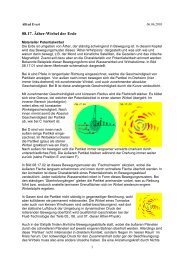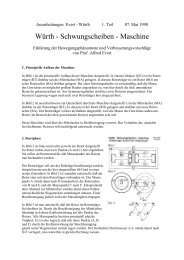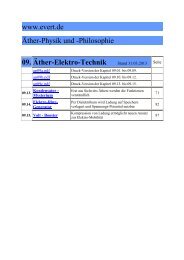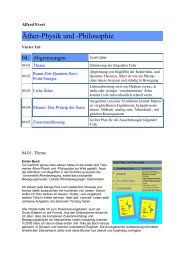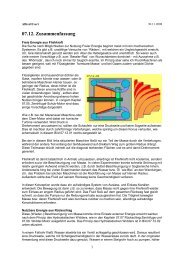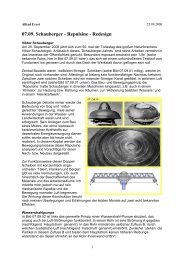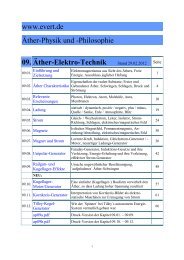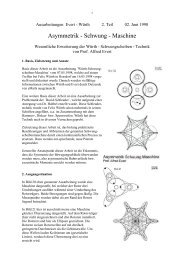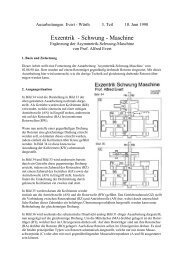Create successful ePaper yourself
Turn your PDF publications into a flip-book with our unique Google optimized e-Paper software.
given. Water thus temporary will flow downward-outward based on centrifugal forces, like marked at A.<br />
At the other hand, temporary will occur back-stroke B, within rotor running around in turning sense of<br />
system.<br />
That back-stroke pressure-wave also runs upward within that hollow cone and is mirrored downward<br />
again. At a whole thus water within rotor becomes accelerated in turning sense. When valves are<br />
open, water vehemently are pushed off by mirrored pressure wave. Openings of turbine and of<br />
housing as well must have smooth edges, e.g. like sketched quite downside at this picture. So this<br />
turbine has null blades, but fast turning water by friction at outer walls is generating usable turning<br />
momentum.<br />
Laval-Nozzles at Wind-Tower<br />
Already at chapter 06.03. Ultrasound-Engine of previous part, motion processes were discussed<br />
resulting ultrasound-fast flows by Laval-Nozzles. Within bottlenecks occur increased number of<br />
multiple-collisions, where e.g. two molecules transfer their kinetic energy onto third molecule same<br />
time. That ´racer´ thus flies by over-size speed into following wide outlet area and comes forward long<br />
distances within that relative void. Both energy-delivering molecules stay back within bottleneck by<br />
relative slow movements. These ´stationers´ show few resistance for following collisions, thus have<br />
good chance to become next ´racers´, flying through outlet with some delay however fast speed.<br />
Efficiency of these Laval-Nozzles is approved at many<br />
technical applications. Also diverse experiments to<br />
proposals of previous chapters did result flows of high<br />
speed by input of few external energy. At chapter 07.06.<br />
Wind-Tower-Current-Generator diverse proposals were<br />
discussed for generating mechanic turning momentum<br />
by most simple technology. Picture <strong>07.12.</strong>04 shows an<br />
example of a Wind-Tower by cross-sectional view.<br />
Pump P (green) is simple round cylinder, pulling air into<br />
turning sense (left turning) only by friction at its surface.<br />
That blade-less pump naturally is turned easy. Turbine<br />
T (red) is a hollow cylinder with diameter some wider. If<br />
turbine would have only simple round surface, turbine<br />
would also become turning via air movements. However<br />
there would be ´slip´ and turning momentum could not<br />
be transferred in total.<br />
Now however that surface is shaped that kind, bottlenecks are build and each bottleneck is followed<br />
by wider area. In front of bottleneck, air is dammed up, i.e. turning momentum is transferred onto<br />
turbine. Within bottleneck exists high density, so multiple-collisions occur frequently. Resulting fast<br />
particles fly into following relative void of wider area, finally hitting onto diagonal wall of next<br />
bottleneck, i.e. resulting additional strong thrust.<br />
Generally, mass-throughput in front of and behind of Laval-Nozzle naturally is of same size. However<br />
kinetic energy of fast flow essentially is increased. That energy by parts is transferred via friction onto<br />
surfaces of turbine and also of pump. At the other hand, these fast particles press into next bottleneck.<br />
Static pressure of dense air there pushes onto diagonal turbine-wall. By that arrangement, thus<br />
acceleration-effect of Laval-Nozzle is used by simple technique. However it will demand many<br />
experiments to find best contours and optimum distances at most suitable revolutions.<br />
Schauberger-Repulsine Re-Design<br />
Behind bottleneck of Laval-Nozzle, particles fly with high speed (even by ultra-sound-speed), however<br />
only few particles each time-unit. So within wide area of outlet exists relative few density. That fast and<br />
thin flow is ideal for merging-in ´wrong-air´ analogue to water-jet-pump. Within inlet aside and direct<br />
behind bottleneck, particles purely by chance are pushed into direction of outlet, based on quite<br />
normal molecular movements. Also these particles move at least by sound-speed, realiter by some<br />
500 m/s. As relative few particles from bottleneck fly even faster into likely directions, few resistance<br />
exists for these additional particles. So behind bottleneck of Laval-Nozzle, not only super-fast flow is<br />
generated but also increased mass-throughput is achieved.<br />
3




